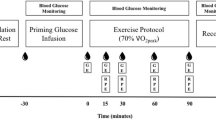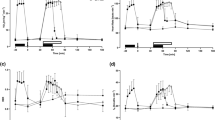Summary
The effects of supramaximal exercise on blood glucose, insulin, and catecholamine responses were examined in 7 healthy male physical education students (mean±SD: age=21±1.2 years;\(\dot V_{{\text{O}}_{{\text{2 max}}} } \)=54±6 ml · kg−1 · min−1) in response to the following three dietary conditions: 1) a normal mixed diet (N); 2) a 24-h low carbohydrate (CHO) diet intended to reduce liver glycogen content (D1); and 3) a 24-h low CHO diet preceded by a leg muscle CHO overloading protocol intended to reduce hepatic glycogen content with increased muscle glycogen store (D2). Exercise was performed on a bicycle ergometer at an exercise intensity of 130%\(\dot V_{{\text{O}}_{{\text{2 max}}} } \) for 90 s. Irrespective of the dietary manipulation, supramaximal exercise was associated with a similar significant (p<0.01) increase in the exercise and recovery plasma glucose values. The increase in blood glucose levels was accompanied by a similar increase in insulin concentrations in all three groups despite lower resting insulin levels in conditions D1 and D2. Lactate concentrations were higher during the early phase of the recovery period in the D2 as compared to the N condition. At cessation of exercise, epinephrine and norepinephrine were greatly elevated in all three conditions. These results indicate that the increase in plasma glucose and insulin associated with very high intensity exercise, persists in spite of dietary manipulations intended to reduce liver glycogen content or increase muscle glycogen store. These data suggest that the blood glucose increase following supramaximal exercise is most likely related to hepatic glycogenolysis in spite of a substantial decrease in liver glycogen content.
Similar content being viewed by others
References
Bergstrom J, Hermansen L, Hultman E, Saltin B (1967) Diet, muscle glycogen and physical performance. Acta Physiol Scand 81:140–150
Brooks GA, Fahey TD (1984) Exercise physiology. John Wiley and Sons, New York, pp 177
Field RA (1960) Glycogen deposition diseases. In: The metabolic basis of inherited disease. McGraw-Hill, New York, pp 156–207
Gollnick PD, Pernow B, Essen B, Jansson E, Saltin B (1981) Availability of glycogen and plasma FFA for substrate utilization in leg muscle of man during exercise. Clin Physiol 1:27–42
Haigh JW, Johnston DG, McCullock AJ, Laker MF, Welby J, Evans S (1982) Assessment of glucose turnover in normal man with the use of a non-radioactive isotopically labelled preparation, [6,6−2H] glucose, as a tracer. Clin Sci 63:437–440
Harper HA, Rodwell VW, Mayes PA (1979) Review of physiological chemistry. Lange Medical Publications, ed 17, Los Altos, pp 299
Harrison MH (1985) Effects of thermal stress and exercise on blood volume in humans. Physiol Rev 65:149–209
Hays WL (1973) Statistics for the social sciences. Holt, Rinehart and Winston, Inc., New York, pp 954
Hermansen L, Pruett EDR, Osnes JB, Giere FA (1970) Blood glucose and plasma insulin in response to maximal exercise and glucose infusion. J Appl Physiol 29:13–16
Hultman E (1978) Regulation of carbohydrate metabolism in the liver during rest and exercise with special reference to diet. In: Landry F, Orban WAR (eds) Third International Symposium on Biochemistry of Exercise. Symposia Specialists Inc., Miami, pp 99–127
Kindermann W, Schnabel A, Schmitt WM, Biro G, Cassens J, Weber F (1982) Catecholamines, growth hormone, cortisol, insulin, and sex hormones in anaerobic and aerobic exercise. Eur J Appl Physiol 49:389–399
Lavoie J-M (1982) Blood metabolites during prolonged exercise in swimming and leg cycling. Eur J Appl Physiol 48:127–133
Lavoie J-M, Hélie R, Cousineau D (1984) Effects of a rapid change in muscle glycogen availability on metabolic and hormonal responses during exercise. Eur J Appl Physiol 53:57–62
Naveri H, Kuoppasalmi K, Harkonen M (1985) Plasma glucagon and catecholamines during exhaustive short-term exercise. Eur J Appl Physiol 53:308–311
Naveri H, Rehunen S, Kuoppasalmi K, Tulikowa I, Harkonen M (1978) Muscle metabolism during and after streneous intermittent running. Scand J Clin Lab Invest 38:329–336
Nilsson LH Son, Hultman E (1973) Liver glycogen in man — the effect of total starvation or a carbohydrate — poor diet followed by carbohydrate refeeding. Scand J Clin Lab Invest 32:325–330
Passon PG, Peuler JD (1973) A simplified radiometric assay for plasma norepinephrine and epinephrine. Anal Biochem 51:618–631
Saltin B, Hermansen L (1967) Glycogen stores and prolonged severe exercise. In: Blix G (ed) Nutrition and physical activity. Almqvist and Wiksell, Uppsula, pp 32–46
Schnabel, A, Kindermann W, Steinkraus V, Salas-Fraire O, Biro G (1984) Metabolic and hormonal responses to exhaustive supramaximal running with and without B — adrenergic blockade. Eur J Appl Physiol 52:214–218
Senay Jr LC, Pivarnik JM (1985) Fluid shifts during exercise. In: Terjung RL (ed) Exercise and sport sciences reviews. MacMillan Publishing Company, New York, pp 335–387
van Beaumont W, Strand JC, Petrofski JS, Hipskind SG, Greenleaf JE (1973) Changes in total plasma content of electrolytes and proteins with maximal exercise. J Appl Physiol 34:102–106
van Beaumont W, Underkofler S, van Beaumont S (1981) Erythrocyte volume, plasma volume, and acide-base changes in exercise and heat dehydration. J Appl Physiol 50:1255–1262
Wahren J, Ahlborg G, Felig P, Jorfeldt L (1971) Glucose metabolism during exercise in man. In: Pernow B, Saltin B (eds) Muscle metabolism during exercise. Plenum Press, New York, pp 189–204
Winder WW, Boullier J, Fell RD (1979) Liver glycogenolysis during exercise without a significant increase in camp. Am J Physiol 237:R147-R152
Author information
Authors and Affiliations
Rights and permissions
About this article
Cite this article
Lavoie, J.M., Bonneau, M.C., Roy, J.Y. et al. Effects of dietary manipulations on blood glucose and hormonal responses following supramaximal exercise. Europ. J. Appl. Physiol. 56, 109–114 (1987). https://doi.org/10.1007/BF00696385
Accepted:
Issue Date:
DOI: https://doi.org/10.1007/BF00696385




